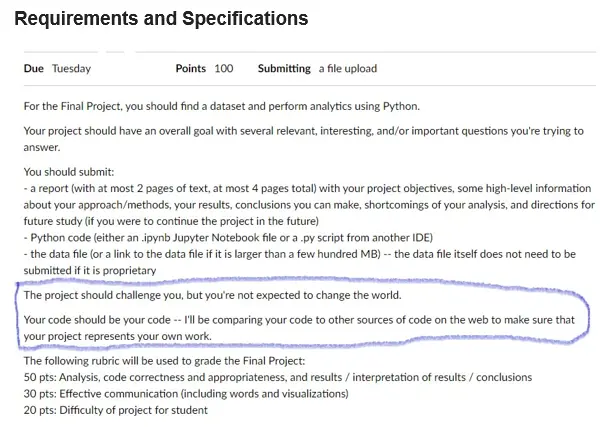Instructions
Objective
Write a python assignment program to implement analytics.
Requirements and Specifications

Source Code
# Data visualization for Flights dataset
### Load needed library
import pandas as pd
import numpy as np
import time
import warnings
warnings.filterwarnings('ignore')
### Import our Data
df = pd.read_csv('flights.csv')
# Data Overview
df.head(100)
df.shape
### know the number of columns and row of our dataset
df.info()
df.dtypes
### know the type of every column
df.describe()
### Descriptive stats for our data
df.isna().sum()
### Check if there is missing data
df.duplicated().sum()
### we do not have any deuplicated rows
df.nunique().to_frame().rename(columns={0:'Count'})
### check the uniqueness of our columns row
df['carrier'].unique()
### know how many carriers that we have in our dataset
df['year'].unique()
df.day.describe()
print(df['carrier'].value_counts())
print(['WN: Southwest Airlines', 'AA: American Airlines', 'MQ: American Eagle Airlines', 'UA: United Airlines',
'OO: Skywest Airlines','DL: Delta Airlines','US: US Airways',
'EV: Atlantic Southeast Airlines','FL: AirTran Airways','YV: Mesa Airlines',
'B6: JetBlue Airways','9E: Pinnacle Airlines','AS: Alaska Airlines','F9: Frontier Airlines',
'HA: Hawaiian Airlines'])
### every airline and its frequency journies
# Data cleaning
### see the missing data
missing_data = df.isnull().sum(axis=0).reset_index()
missing_data.columns = ['variable', 'missing values']
missing_data['filling factor (%)']=(df.shape[0]-missing_data['missing values'])/df.shape[0]*100
missing_data.sort_values('filling factor (%)').reset_index(drop = True)
### we see that those columns (air_time, arr_delay, arr_time, dep_time,dep_delay) have some missing data that we must handel
df=df.dropna()
### remove any row with at least one missing value
df.isna().sum()
### now no nulls
cols=["day","month","year"]
df['date'] = df[cols].apply(lambda x: '-'.join(x.values.astype(str)), axis="columns")
### join the coulmns day month year to one colmun to be the date of our data
### Setting the Frequency
df.set_index("date", inplace=True)
df.head()
### our data now sorted by the date
# Exploratory Data Analysis
import matplotlib.pyplot as plt
import seaborn as sns
import warnings
warnings.filterwarnings('ignore')
#correlation matrix
corrmat = df.corr()
f, ax = plt.subplots(figsize=(12, 9))
sns.heatmap(corrmat, vmax=.8, square=True);
plt.show()
### this heatmap give us an intuation for the corrolation between our dataset columns which indicates that so coluns have very strong correlation like arrival time and departure time, other have so low correlation like arrival delay and distance.
delay_type = lambda x:((0,1)[x > 5],2)[x > 45]
fig = plt.figure(1, figsize=(10,7))
ax = sns.countplot(y="carrier", hue='year', data=df)
# Setting Labels
plt.setp(ax.get_xticklabels(), fontsize=12, weight = 'normal', rotation = 0);
plt.setp(ax.get_yticklabels(), fontsize=12, weight = 'bold', rotation = 0);
ax.yaxis.label.set_visible(False)
plt.xlabel('Flight count', fontsize=16, weight = 'bold', labelpad=10)
### this count plot give us an observiation on which is the most airlines have made flights in 2013
### we find that it is UA and B6 have most flights for 2014 where is very low flights for OO(SKYWEST)
#Status on time (0),
#slightly delayed (1),
#highly delayed (2),
for dataset in df:
df.loc[df['arr_delay'] <= 10, 'Status'] = 0
df.loc[df['arr_delay'] >= 10, 'Status'] = 1
df.loc[df['arr_delay'] >= 30, 'Status'] = 2
f,ax=plt.subplots(1,2,figsize=(20,8))
df['Status'].value_counts().plot.pie(autopct='%1.1f%%',ax=ax[0],shadow=True)
ax[0].set_title('Status')
ax[0].set_ylabel('')
sns.countplot('Status',order = df['Status'].value_counts().index, data=df,ax=ax[1])
ax[1].set_title('Status')
plt.show()
### In 2013, a 71% of flights were delayed by more than 10 minutes. 12.9% of flights had delays of more than 10 min and less than half hour.On the other hand, 16.6% above hour
delay = df[(df.Status >= 1) &(df.Status < 3)]
#histogram
sns.distplot(delay['arr_delay'])
plt.show()
### It can be seen that delays are mostly located on the left side of the graph,The most of delays are short, and unusual we have very large delay
fig = plt.figure(figsize=(20,8))
delay[['month','arr_delay']].groupby(['month']).mean().plot()
plt.show()
### Delays focused on February, June and December, might the cause of the sumer and winter holidays
fig = plt.figure(figsize=(20,8))
delay[['hour','arr_delay']].groupby(['hour']).mean().plot()
plt.show()
### it is clear the the delays is rush between the 17:21 hour
carrier_delay = df[['hour','carrier']].groupby(['carrier']).head()
carrier_delay
df.arr_delay.plot(figsize=(20,5))
plt.title("delays over 2013", size = 24)
plt.ylim(0,1400)
plt.show()
f,ax=plt.subplots(1,figsize=(20,8))
sns.barplot('carrier','arr_delay', data=delay,ax=ax,
order=['WN', 'AA','B6','AS', 'MQ',
'UA','OO','DL','US','EV','FL',
YV', '9E','F9','HA'])
### We find the the Airlines 'OO: Skywest Airlines', 'YV: Mesa Airlines','9E: Pinnacle Airlines', and 'EV: Atlantic Southeast Airlines' have the most delays time along all the dataset. in other way the Airlines 'UA: United Airlines', 'AS: Alaska Airlines' have the least time delay over all carriers.
Similar Samples
Explore our array of programming assignment samples at ProgrammingHomeworkHelp.com. These examples showcase our expertise across various languages such as Java, Python, C++, and more. Each sample exemplifies our commitment to clarity, efficiency, and problem-solving skills, ensuring your academic success in programming. Dive into our samples to see how we can assist you!
Python
Python
Python
Python
Python
Python
Python
Python
Python
Python
Python
Python
Python
Python
Python
Python
Python
Python
Python
Python
.webp)